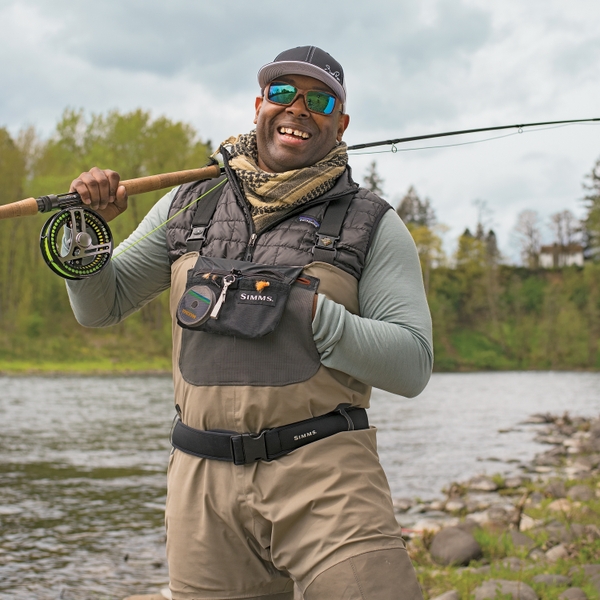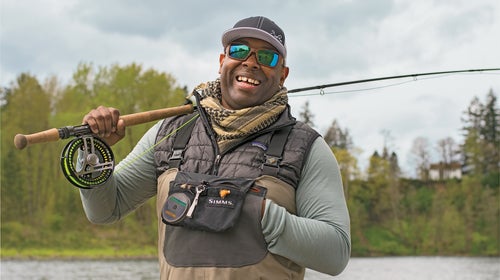The PTSD River Cure
Chad Brown put down a gun and picked up a fly-fishing rod. The Navy veteran turned gear designer now wants kids and vets to heal each other on the great American waters that saved his life.
New perk: Easily find new routes and hidden gems, upcoming running events, and more near you. Your weekly Local Running Newsletter has everything you need to lace up! .
So an Irish American, a Mexican American, an African American, an Asian American, and an Irish-Ukranian-Filipino American walk into a bar. Actually, it’s a breakfast bar. It’s zero dark thirty on a cold January morning, and we’re at a tiny café in Oregon’s Willamette Valley. After some coffee, we are going to chase winter steelhead.
But we don’t actually get to the steelhead, not yet. When the coffee comes, it’s still dark, and still winter. So the most multiethnic breakfast party in the history of Oregon sits down to talk. The sport of steelhead fishing has its own complicated rituals and lingo: there are “big sticks,” or double-handed fly rods, and “the D-loop,” a Jedi-style motion that can fling out a long, heavy line. Regular sticks are just oars. “Double Speys” and “snake rolls” are casting techniques from Scotland; “Scandis” are Swedish lines well adapted to these big Oregon waters.
Let’s deal with the fish right away. About 20 inches long, sometimes much more, steelhead are named for their dull silver, bullet-shaped heads, but depending on their life stage and the time of year, they can be silver-bright from the ocean or passionately colored like mutant rainbow trout. Big and strong, they have the habits of salmon, like going to sea and then, upon their return, refusing to bite a fisherman’s hook. They’re so hard to catch that they’re known as gray ghosts.
“You hear some anglers call them unicorns,” says Chad Brown, the black guy with the deep voice surrounded by fishing buddies. Unicorns are talked about but never seen. Chad’s been fishing for steelhead for four years and hasn’t caught one yet.
Steelhead are the real reason for this gathering, but Chad is the excuse. He’s a U.S. Navy veteran who participated in Desert Storm and Desert Shield, served at Guantánamo Bay, and saw combat during Operation Restore Hope, in Somalia, during the infamous Black Hawk Down era. That he came back with post-traumatic stress disorder is no news in this era—since 2001, more than 378,300 U.S. military personnel have sought treatment for potential PTSD from Veterans Affairs facilities—but he’s also an artist, designer, and educator who believes, he told me at breakfast, “in finding a way to radiate your pain outward to help others.”
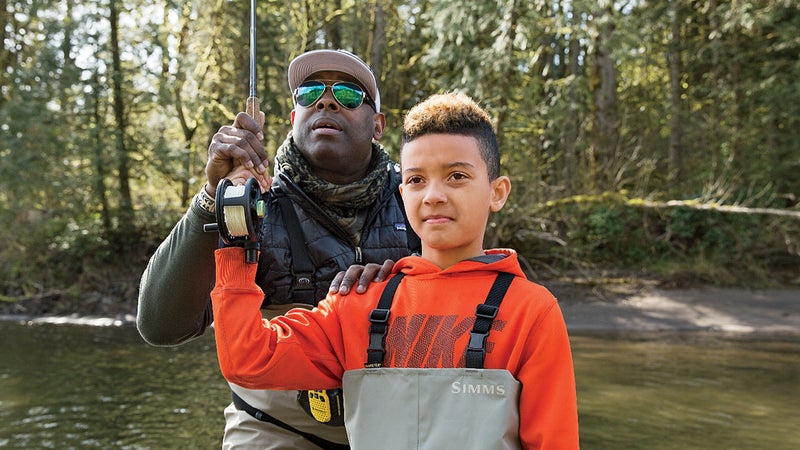
That formula has produced , a left-right punch of fly-fishing lifestyle brand and do-gooder project that Chad founded in 2013. Soul River is a boutique storefront in the Kenton neighborhood of North Portland, one of the only substantially black areas in the city, where Chad sells gear, books trips, and invites anglers to sip kombucha and contemplate the artistic value of a size five purple Deal Breaker fly. He also sells his own line of gear and clothing, weaponized with touches of military-grade functionality that bring a little urban snazz to the dorky world of drip-dry. The boutique is also home to , the 501(c)(3) nonprofit through which Chad runs educational trips to help at-risk kids connect with the outdoors. His irresistible twist is to tap fellow veterans to mentor his students. Meanwhile, he’d like to catch a steelhead himself. Just once.
“They’ve been called the fish of a thousand casts,” says Michael Davidchik, the Filipino American, a 39-year-old emergency-room nurse. “Sometimes ten thousand.”
In fact, the state of Oregon estimates that anglers can spend up to 73 hours wetting a line for each steelhead they land. “If you are lucky,” says Brian Chou, a man so steeped in steelhead fishing that rod companies ask him to test their designs. Brian, a 38-year-old Asian American health coach and English tutor, is the man who oversaw Chad’s entry into the steelhead cult. “We’re the definition of lunacy,” he says. “We keep doing the same thing over and over again, expecting a different result.”
Jaime Delgado, the Mexican American, isn’t having it. Born in San Diego, the 38-year-old is a cold killer on the water. He says he can cut the price of entry down to just 500 casts through a combination of fishing apps, cubic-feet-per-second flow figures, and—the whole table contributes to this list—a knowledge of water temperature, clarity, and (Chad’s addition) air pressure, combined with the right equipment, technique, depth, and presentation, along with care in choosing the place, season, and time of day. And they’re willing to let me—the Irish guy—into the circle of knowledge, provided I don’t share their secret fishing spots.
Chad believes “in finding a way to radiate your pain outward to help others.” That formula has produced Soul River, a left-right punch of fly-fishing lifestyle brand and do-gooder project.
We head out after breakfast and drive up the banks of the [redacted], between the [deleted] and the [deleted]. We park at [nowhere] and drop two rafts in the river. We spend a long, cold morning drifting some of the river’s best-known holes, like [deleted], a sweeping run between two rapids. There are five of us: Jaime and Michael drift together, staring at the water; Chad and I ride at the ends of Brian’s cataraft. The boats are too small for much fishing, so we beach and then walk stretches, unfurling long casts, focused on the banks. The [redacted] is a fast river but slows during wide horseshoe bends or above and below rapids, and the steelhead gather in those places, resting.
We float seven miles but don’t catch a thing. Not even a nibble.
I swore not to reveal our whereabouts, but we were just [illegible] miles from Portland, and after lunch I slathered my photographic evidence all over Facebook.
I first met Chad Brown last October on the Deschutes, the classic steelhead river that runs through dry central Oregon. I’d had beginner’s luck, landing my first steelhead, a shining silver arrow 21 inches long that had literally pulled me into the cold river and left me soaked, renewed, and finally triumphant. As I dried out in the sunshine, Chad rolled past in a matte black Land Rover with tinted windows and a Thule cargo box on top. He was leading two other vehicles filled with kids, teens, and a few older men. Everyone was African American, which is slightly uncommon on the Deschutes. (Just 2 percent of Oregon’s population is black, and most of them live 100 miles west, around Portland and Eugene.)
Later I could see several big tents going up. On my way out, I stopped to help two of the kids find some cooking water and met Johnie Tucker, from the parks and recreation department of Vancouver, Washington, across the river from Portland. He and Chad were leading a series of outdoor-education trips to the Olympic Peninsula, the Deschutes, and the Sandy River. In the jargon, the youth—who on this trip ranged in age from six to seventeen—were “underserved,” from poor or minority backgrounds with little access to the outdoors. A few were in some kind of trouble, but others came from church groups or single-parent families that simply didn’t have the money, time, or culture of the outdoors.
“With a lot of inner-city kids, the forest is taboo,” Tucker explained. “That’s a cultural thing.” He’d joined forces with Chad and his team, which included Brian Chou and a young Seattle Army vet named Matthew Dahl, to teach them fly-fishing and all the things that come with it—etymology, camping, casting, and why a pair of Nike basketball shoes is not the best choice for wading through a river. “Think about it,” Chad told me as a cold wind whipped the campsite. “They’ve always been told, ‘Stay out of the water, it’s dangerous.’ ” But three hours east of the city, the kids were set free, in high spirits as they threw on their waders and posed for selfies.
“Are there really fish in there?” a skeptical girl of about ten asked me. I tried to inspire her with a detailed account of landing my steelhead, but all she heard was an old man talking. Everyone waddled down to the Deschutes, bravely stepping into the long nightmare that is steelheading.
“Chad’s the man,” Tucker told me, praising the vet’s ability to get through to a dozen slightly scruffy teens.
Recognizing that he was a veritable checklist of qualities it was seeking to promote—educator of children, veteran, entrepreneur, advocate for greater access to the nation’s wilderness areas—the U.S. Fish and Wildlife Service partnered with him to fund more trips. The agency brought him to Washington to speak on Capitol Hill, where he urged members of Congress to fund the , and is arranging for him to fly at-risk kids up to Alaska to fish with young Native American leaders. After a September 2014 speech to leaders of the National Wildlife Refuge Association, he was invited to join their board.
The fishing industry has taken note as well, with companies like Simms and Costa offering sponsorships and donating gear. Loop, the rod and reel manufacturer, hired Chad as a brand ambassador, filling its catalogs and social-media feeds with images of him. Loop USA’s lead salesman, James Park, says he liked Chad’s work with kids and his idea of using veterans to reach them. But Park is blunt about race as well. “To be frank, that’s the number-one reason I reached out to Chad,” he says. “I myself am Korean American and about the only Asian guy at my level in the industry. At any event, Chad and I stick out like sore thumbs.”
Park says that even when he’s had an appointment, he’s sometimes been greeted in fly shops by clerks who assumed he was lost and spoke extra slowly as they steered him back outside. The problem is not so much racism, Park says, as our collective River Runs Through It vision of Brad Pitt on the Bighorn—the expectation, reinforced in nearly all advertising, that fly-fishing is done by elite white males. But the sport, Park says, is already more diverse than its image. According to the , a nonprofit created by the Outdoor Industry Association to increase youth participation, 13.8 percent of people who said they fly-fished in 2013 self-identified as black or African American. Loop’s social-media posts about Chad get three times the average viewership, Park notes, but really any kind of diversity seems to work. (Posts about a 57-year-old woman angler got 13 times the usual interest.)
Chad’s many projects can be overwhelming, people’s expectations intense. Orvis wrote him out of the blue in March, asking if they had his e-mail address right, because he just won their inaugural (“We think the work you are doing for inner-city kids and veterans is awesome”) and the brand wanted to fly him to Montana to collect it in front of 500 dealers and guides.
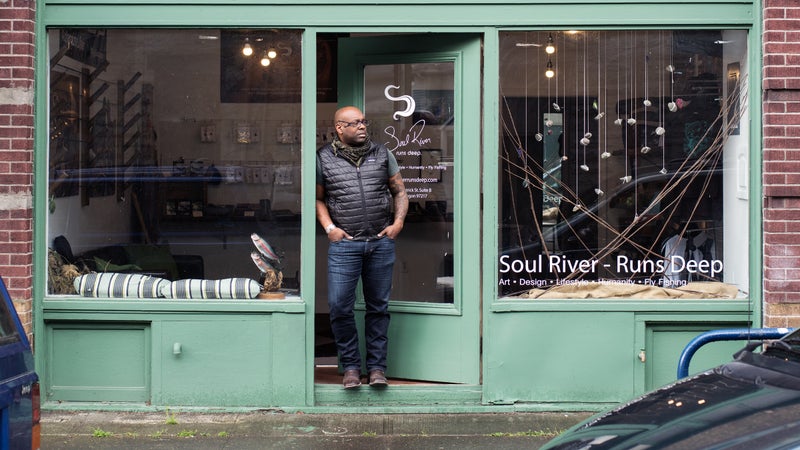
Chad received a donation of equipment from another Oregon wilderness educator I know, Jeff Gottfried, who also works with marginalized kids. Gottfried says he’ll continue to help Chad “however I can, and more power to him.” But, he warns, “the biggest risk for him is burning out.” Chad has been fly-fishing for only a few years, yet he’s somehow supposed to educate Washington policymakers on the realities of conservation and advocate (and embody) getting minorities into our wild places. He’s supposed to link vets with kids and get them all in the wilderness but meanwhile support himself with a fishing boutique and a tenuous career as a gear designer.
People want to see Chad succeed, almost too much. People want to help.
“How could you not?” Park says.
In the book Black Hawk Down, Mark Bowden describes how Army Rangers preparing to fast-rope from helicopters into the city of Mogadishu looked out to sea and saw a flotilla of Navy support ships filling the horizon. That was Chad out there.
It was 1993. He had joined the Navy at 20, and after two Gulf War deployments he found himself riding ashore in Somalia on a Navy landing craft, wearing body armor and carrying an M16. He was a combat stevedore; for ten months, he patrolled the piers where the Navy landed supplies and then convoyed them to a rusting aircraft hangar on the city’s edge, where strike troops lived. The hangar was depicted in the movie version of Black Hawk Down (accurately, Chad says) as a dirty oven full of Army snake eaters and Navy cowboys, CIA spooks and 19-year-old Rangers, sitting around customizing weapons and gear. Chad saw the fast and light approach of the Special Forces, the flexibility of search and rescue gear, the Navy penchant for bail-out buckles and instant access.
Each visit to the hangar meant passing through Mogadishu streets. There were hours spent guarding street corners, always on hair-trigger alert but governed by strict rules of engagement. On convoys the soldiers were trained to watch for anyone approaching the vehicle, but here in the city everyone approached all the time—men, women, and children crowding the narrow streets, curious. Chad’s pockets were full of zip ties for handcuffing potential threats.
“Mogadishu was nasty,” he says. “A beehive.” They were picked at by snipers and sometimes mortared. One of his buddies was killed.
“At the time, I was all gung-ho,” Chad says, but later he was troubled, wondering at his own role in reducing proud Somali men to prisoners.
He left the service in 1994 and, with help from the GI Bill, finished college and got a master’s in communication and design from the Pratt Institute in New York City. He spent seven or eight years in the Manhattan ad world, designing brands and campaigns, earning money, developing his taste for minimalist design. “New York was so fast,” he says, “my mind didn’t have time to relapse.”
Then came Oregon. In 2008, Chad took a contract job in Portland but was unmoored by the experience. “That’s when everything just went south for me,” he says. He was too far away from family—specifically his mother in North Carolina and his father, who still lives near Austin, Texas, where Chad grew up. Oregon’s slower pace gave him time to think, and remember, and to sink into a downward spiral. He started drinking, lost his contract job, and fell into depression, too ashamed to ask his parents for help.
“I'm medicated,” Chad told me once. “Fishing was my healing. It evolved me to a place where I was ready to get back in society and kick ass.”
“I was deteriorating every month I was away from my family,” he says. “No one to turn to. I was in a dark place.” He became “borderline homeless,” he says, routinely selling his blood for gas money. He felt broken in a way that couldn’t be fixed, and in the summer of 2009, he went to the Clackamas River, took out a gun, and prepared to shoot himself. Something, probably the river itself, with its steady pull of gentle power, held him back. He called his mother, who called the Veterans Affairs suicide hotline. He was placed in a padded room in a VA psychiatric ward.
At the VA, Chad was known by the last four digits of his social-security number. Every morning he was handed a paper cup full of two or three different medications. After four days he was let out of the psych ward, but he remained in a VA clinic, learning more about post-traumatic stress. A suite of ugly realities are swept up in the cozy abbreviation PTSD: tricks of memory, sleepless nights, emotional instability, substance abuse, depression, anxiety, thoughts of suicide, and flattening doses of pharmaceuticals. That all sounded about accurate to Chad, a description of who he had become.
The turning point came months later, when a VA attendant took him bass fishing. This was at Clackamette Park, a suburban oasis in Portland where the Clackamas and Willamette Rivers meet. On his first try, Chad accidentally hooked a jack (or early) salmon. He lost the fish, but “I was whooping and hollering,” he recalls. “It made me feel alive. I hadn’t smiled for so long.”
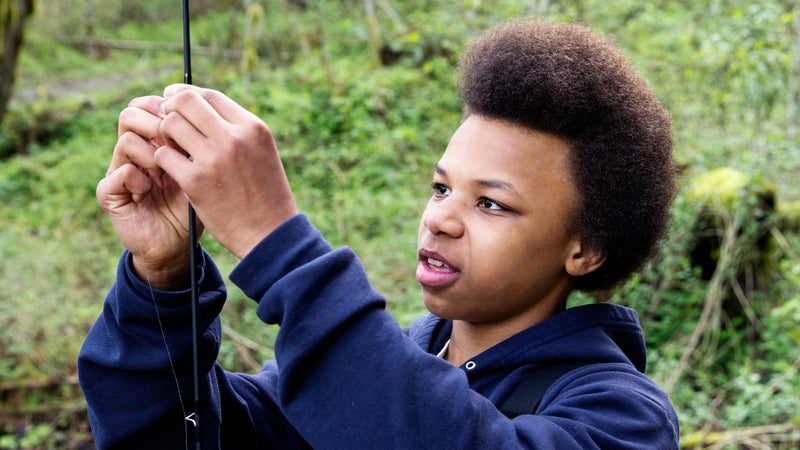
Back in Texas, the men in Chad’s family had been hunters, and his dad was an avid hiker. But Chad spent his childhood making art and never knew the atavistic thrill of a hooked fish. He kept going back to the park to try again. (“It’s not like I had anything else to do,” he says.) The next spring, on a road trip to the Umpqua River, an emerald ribbon in southern Oregon, he was floored more by the water’s colors than by any fish in it. That day he entered a tackle shop for the first time and found what would become his true therapy: fly-fishing. The reels fascinated him, and the brilliantly colored lines were beguiling. He was in debt but put down a credit card and bought a kit. He learned casting from YouTube and started heading out alone, with whatever flies the shops recommended.
In a haze of medication, Chad lost track of time, wandering out to rivers during 2010 and 2011. Finally, he got lucky again. He found the Sandy River so thick with fall salmon, he says, that “I thought I was in a National Geographic photo.” He waded in and hooked one on his fourth cast. This time the hook, line, and rod all held. Chad did not. The salmon fought hard and then abruptly turned upstream and came toward him, throwing a bow wake. “I actually got scared,” Chad says. “I didn’t know what to do, so I dropped my rod and started running in the opposite direction. I was screaming, ‘Help, the salmon is coming after me!’ and running.”
A lot of anglers watched the black man run up the river, chased by a salmon. Only one came over. That was Brian Chou.
Brian explained that there were ways to control a fish, even a big salmon. Over the next couple of years, as the two men ran into one another at fly shops and started fishing together, Chad’s interest became an obsession. He fished with Brian and without him, the hours on the water the most effective prescription possible.
“I’m medicated,” Chad told me once, referring to rivers. “That was my healing. Fishing evolved me to a place where I was ready to get back in society and kick ass.” On the Sandy one day in 2011, he says, “I was standing in the water waist deep, and I thought, This river has basically saved my life. I’ve got to do something for others. It became about more than just me, and that’s when my design side started to kick in.”
Chad’s dream was to imitate Patagonia founder Yvon Chouinard, using a gear business to fund education and conservation. He wanted to get kids on the water by soliciting donated equipment and grants to help reduce the cost of fly-fishing from “freaking expensive” to zero.
Working from his apartment, he tried designing fly reels but abandoned that for river-and-urban-friendly clothing and bags. He marketed the designs to fishermen at meetups, where his personal story earned him speaking invitations. In 2013, he got his first Fish and Wildlife contract to take kids out; in 2014, he landed his deal with Loop and by July had opened the boutique.

Chad calls Soul River a mashup of “art, design, humanity, fly-fishing, and outdoors.” In the small retail space, Soul River Runs Deep, he offers just a few exquisite examples of outdoor equipment: waterproof notebooks, clasp knives from New Zealand, and a spectacular array of flies, dated and signed by each creator and priced as works of art. One wall is filled with his own Soul River line. Backpack drybags come in subtle colors, for the “stream bank to boardroom” transition. A fishing jacket makes you look like Bruce Lee instead of Don Knotts. T-shirts and $25 caps feature his tattoo-style artwork of fish, trees, and nymphs. And Chad’s Soul River messenger bag justified the $220 price tag by solving a lot of problems for me: big enough for groceries, but with a pocket sized for an iPad, tie-downs for wet gear, and an unusually high and tight shoulder position that can survive motorcycling, yet pops off with a Special Forces–style Cobra quick release. But his real signature is a line of slightly transgressive American-flag kaffiyehs featuring Old Glory in alternate color schemes (desert camo or night-stalker black on green). “It’s antiwar, basically,” he says, but his designs are so distinctively his own that they need little explaining.
The boutique’s larger back room is home to Soul River Runs Wild, the nonprofit. Here, on a huge conference table hand-painted with his designs, Chad hosts advocacy events and fly-tying contests for kids. He dedicates 15 percent of what’s earned up front to the nonprofit in back.
Chad doesn’t make any money from Soul River, yet. There aren’t a lot of fly-fishermen in this neck of Portland; so far the website, , accounts for half his sales. But through a combination of education grants, speaking gigs, design consulting, and a small Navy disability check, this barely paid advocate for the healing power of wild places is finding his feet, financially and otherwise.
Having failed utterly to catch or even detect a steelhead in January, we head back out in February. This time we fish on foot. We park near [inaudible], where Brian has found a gate recently opened to the public. We cross onion fields and then clamber through forest to reach the banks of the [no signal] hole, a long run we fished on the float trip.
Under Brian’s expert direction, we mostly work the banks. Or, I should say, they work the banks. I’ve been fishing up to now with a conventional single-handed rod, but Chad passes over an extra Spey rod and teaches me the fundamentals of two-handed casting, where you pick up and then unroll the thick line. The rod is so big—typically 13 or 14 feet—that when it works, you can shoot dozens of yards of line across deep water.
After ten minutes of Chad’s instruction, I drop a hook 45 feet across the [redacted] and start throwing my quota of a thousand—or was it ten thousand?—casts.
Nothing. Nothing. Nothing. Hours. McKenzie drift boats float by. (“Anything?” “Nothing. How about you?” “Nothing.”) The fishing was good last week, like always, but this day the unicorns are in hiding.
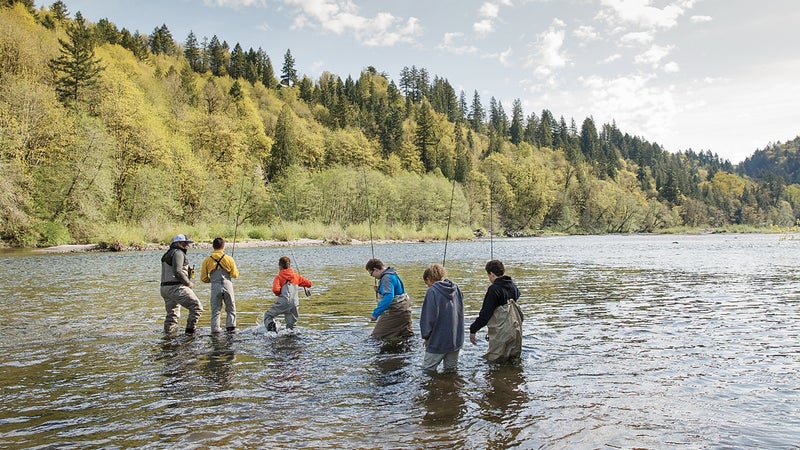
Chad still hasn’t caught his first steelhead. (“The varmints!” he jokes.) This fish practically saved his life, but it’s sitting out there in the river right now, ignoring him.
A long cold day of defeat. So why is everyone so happy?
At one point, Brian jokingly orders Chad to fish a run by saying, “Go on, take your medicine.” But it doesn’t require the battle of Mogadishu to stress you past the breaking point. Brian is a compulsively busy guy, with two small businesses, the kind of man who reverse-engineers blended-plastic fly lines for relaxation. Michael works in an emergency room and is going through a custody battle. Jaime grew up in a rough patch of Southern California and would drive halfway across Oregon for the hope of a river, the tug of a fish. I’ve worked in five war zones and am looking for my own cure. We all want that sustained meditation that comes from standing by a river.
Yes, meditation. Like surf, tides, and rain, a fly-fishing river displays statistical reliability—the flow of water changes constantly but in a relaxing, predictable way. Moving water, researchers have found, permits a deep state of attention that is easy and restful, especially compared with the depleting alarms of electronic life, the flat harshness of living and working in boxes. By scientific standards, our fishing party is an oxytocin fest, our mirror neurons firing in tribal unison as we all flood with GABA, the feel-good neurochemical, and slow-burn endorphins. Even doctors know this works. In 2009, a Salt Lake City VA study of 67 veterans with PTSD showed that, surprise, after a four-day fishing trip, their salivary cortisol (and salivary immunoglobins, and urinary catecholamines) were way down. Which is good.
So you could get your drugs by sitting for eight hours in a VA waiting room. But you could also take the other medicine, what biologist Wallace J. Nichols has called the “blue mind” treatment of running water. Chad is doing both, taking his government meds but also hunting his steelhead, the long road of a tired small-business man struggling to live up to everyone’s hopes. On this trip he looks drawn and tired; he says the “low points” are back. Then he wades out into the river.
“When I am able to help Chad medicate,” Brian says, watching, “it makes me feel like I have a purpose.”
Aren’t we all taking our medicine in the outdoors? When did that become a joke? No, the joke is the fish itself. Chad doesn’t get his steelhead that day. But another drift boat passes by and suddenly, insultingly, hooks one. The anglers pull over and, right in front of us, play and land the fish on a $20 rod from Walmart, using a big pink spoon.
So much for Spey rods. So much for the never-seen unicorn. The gray ghost is right here, just another silvery fish flapping its gills. They bleed it out and put it on ice and leave.
We all stand around in the weak winter sunshine, happy. The drugs are beginning to take effect.
Contributing editor Patrick Symmes () is the author of the forthcoming book The Day Fidel Died, on the Cuban revolution.
